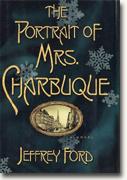The Portrait of Mrs. Charbuque
Jeffrey Ford
book reviews:
· general fiction
· chick lit/romance
· sci-fi/fantasy
· graphic novels
· nonfiction
· audio books
· author interviews
· children's books @
curledupkids.com
· DVD reviews @
curledupdvd.com
newsletter
win books
buy online
links
home
for authors
& publishers
for reviewers

 |
The Portrait of Mrs. Charbuque Jeffrey Ford William Morrow Hardcover 320 pages June 2002 |
|
In a piece written for the online journal Fantastic Metropolis, Jeffrey Ford describes the inspiration for his novel, The Portrait of Mrs. Charbuque. He tells of the sociology of modern art—the effects of photography on the prestige of portrait painting and the new tension of art as the product of individual inspiration versus art as commissioned representation. But Ford cites an unexpected, additional inspiration: two bits of lore surrounding Emily Dickinson. The first was her habit of sitting behind a screen when people visited and, second, was that her friend Mabel Loomis Todd claimed to know “Emily her entire life but only actually saw her in her coffin.” When Ford looked to confirm this anecdote for a lecture, he found no reference to it. That this Dickenson lore may be only that, and that the second anecdote may be only the product of Ford’s imagination, sets the tone for the strangeness, the ineffability of this novel. Nothing in this novel is certain—its genre, its twists and turns.
It is here that Ford switches from the mysterious to mystery, turning his novel into a tour of the nineteenth-century New York demimonde. Ford uses the turn-of-the-century city as the canvas for his larger inquiry. New York City, with its underworld just around the corner from its high society, where the “new deity” of fortune reigns, provides the right combination of menace and possibility. Like Kafka's works, The Portrait of Mrs. Charbuque questions the possibility of knowing and supplies the reader with abstruse parables and one thousand questions. What can the senses tell us that the mind cannot? Is gender essence or construction? What is inspiration? What is art? But to some extent, these are as cruel a parlor game as Mrs. Charbuque’s. We get no certainty here, but then this is art not portraiture. © 2002 by Martin Schmutterer for Curled Up With a Good Book |
|
|
|
 Click here to learn more about this month's sponsor! |
|
| fiction · sf/f · comic books · nonfiction · audio newsletter · free book contest · buy books online review index · links · · authors & publishers reviewers |
|
| site by ELBO Computing Resources, Inc. | |
 The novel begins as successful portrait painter Piambo unveils his most recent painting to a decidedly mixed reaction. Yearning to paint what strikes his heart rather than the lucrative portraits, Piambo remains unmoved by his muse. Coincidently he receives a mysterious commission (more of a devil’s bargain, really) from an unknown patron. She has offered him enough money to abandon portrait-painting if he fulfills his commission to paint her portrait. There is one catch: Piambo will not be able to see her, this Mrs. Charbuque, and is not allowed to ask about her appearance. How does one begin to paint her? Piambo divines the magic of her childhood—Mrs. Charbuque tells tales of twin snowflakes, failed mystics and cruel murders. Piambo persists and, with the help of his friend Shenz and an occultist, begins to see Mrs. Charbuque. But as the image becomes clearer, things grow more difficult for Piambo, as he encounters a mysterious plague, a monkey’s paw, and a new menace—the long lost Mr. Charbuque.
The novel begins as successful portrait painter Piambo unveils his most recent painting to a decidedly mixed reaction. Yearning to paint what strikes his heart rather than the lucrative portraits, Piambo remains unmoved by his muse. Coincidently he receives a mysterious commission (more of a devil’s bargain, really) from an unknown patron. She has offered him enough money to abandon portrait-painting if he fulfills his commission to paint her portrait. There is one catch: Piambo will not be able to see her, this Mrs. Charbuque, and is not allowed to ask about her appearance. How does one begin to paint her? Piambo divines the magic of her childhood—Mrs. Charbuque tells tales of twin snowflakes, failed mystics and cruel murders. Piambo persists and, with the help of his friend Shenz and an occultist, begins to see Mrs. Charbuque. But as the image becomes clearer, things grow more difficult for Piambo, as he encounters a mysterious plague, a monkey’s paw, and a new menace—the long lost Mr. Charbuque.